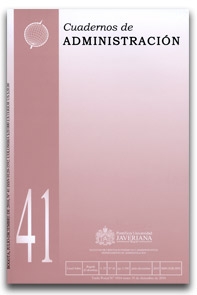Abstract
The main objective of this research is to verify the validity of capital structure theories with financial hierarchization and target gearing models for examining how companies finance themselves in Latin America. A sample of corporations from Argentina, Brazil, Chile, Mexico, and Peru that assumedly had traded in their respective stock markets during the period 1995 – 2007 was selected. Using a panel study, the hypothesis of financial hierarchization was rejected; that is to say, financial hierarchization does not explain the policy of indebtedness that the Latin American companies have. On the contrary, findings indicate that such companies prefer to become indebted and enjoy the benefits as well as the costs that indebtedness entails than to finance themselves with the funds that they have generated. Thus, the authors conclude that when it comes to their capital structures, apparently for the period under study, Latin American companies’ behavior rather follows the target gearing model.
Booth, L.; Aivazian, V.; Demirguc-Kunt, A. and Maksimovic, V. (2001). Capital structure in developing countries. The Journal of Finance (56), 1-44.
De Medeiros, O. and Daher, C. (2004). Testing static trade off against pecking order models of capital structure in Brazilian firms. Recuperado el 8 de mayo del 2009, de http://ssrn.com/ abstract=631563.
Fama, E. and French, K. (2002). Testing trade-off and pecking order predictions about dividend and debt. Review of Financial Studies (15), 1-37.
Farhat, J.; Cotei, C. and Abugri, B. (2009). Testing trade-off and pecking order models under different institutional environments. Recuperado el 5 de mayo del 2010, de http://ssrn.com/abstract=1404596.
Fernández, M.; De Rojas, M. y Zuliani, G. (2004). Contrastación de la teoría del Pecking Order: el caso de las empresas españolas. Valladolid: Universidad de Valladolid.
Frank, M. and Goyal, V. (2000). Testing the pecking order theory of capital structure. Recuperado el 2 de mayo del 2009, de http://ssrn.com/abstract=243138.
Trade-off and pecking order theories of debt. (2007). Recuperado el 4 de mayo del 2009, de http://ssrn.com/abstract=670543
Jalilvand, A. and Harris, R. (1984). Corporate behavior in adjusting to capital structure and dividend targets: An econometric study. Journal of Finance (39), 127-145.
Leary, M. and Roberts, M. (2005). Financial slack and tests of the pecking order's financing hierarchy. Working Paper. Durham, NC: Duke University.
Leland, H. (1994). Corporate debt value, bond covenants, and optimal capital structure. Journal of Finance (49), 1213-1252.
Toft, K. (1996). Optimal capital structure, endogenous bankruptcy, and the term structure of credit spreads. Journal of Finance (51), 987-1019.
Miller M. (1977). Debt and taxes. Journal of Finance (32), 261-275.
Rock, K. (1985). Dividend policy under asymmetric information. Journal of Finance (40), 1031-1051.
Mira, F. (2002). On capital structure in the small and medium enterprises: the Spanish case. working paper series. Madrid: Instituto de Estudios Europeos-Universidad San Pablo CEU.
Modigliani, F. and Miller, M. (1958). The cost of capital, corporation finance and the theory of investment. American Economic Review (68), 261-297.
Corporate income taxes and the cost of capital: a correction. (1963). American Economic Review (53), 433-443.
Myers, S. (1984). The capital structure puzzle. Journal of Finance (39), 575-592.
Majluf, N. (1984). Corporate financing and investment decision when firms have information that investors do not have. Journal of Financial Economics (13), 187-221.
Pandey, I. (2001). Capital structure and the firm characteristics: evidence from an emerging market. Working paper 2001-10-04.Ahmedabad: Indian Institute of Management.
Seifert, B. and Gonenc, H. (2010). Pecking order behavior in emerging markets. Journal of International Financial Management and Accounting, 21 (1), 1-31.
Şen, M. and Oruç, E. (2008). Testing of pecking order theory in Istanbul stock exchange market. International Research Journal of Finance and Economics (21), 19-26.
Shyam-Sunder L. and Myers, S. (1994). Testing static tradeoff against pecking order models of capital structure. National Bureau of Economics Research, 4722, 1-35.
Testing static tradeoff against pecking order models of capital structure. (1999). Journal of Financial Economics (51), 219-244.
Singh, P. and Kumar, B. (2008). Trade off theory or pecking order theory: what explains the behavior of the Indian firms? Recuperado el 5 de septiembre de 2009, de http://ssrn.com/abstract=1263226
This work is licensed under a Creative Commons Attribution-NonCommercial-ShareAlike 3.0 Unported License.


